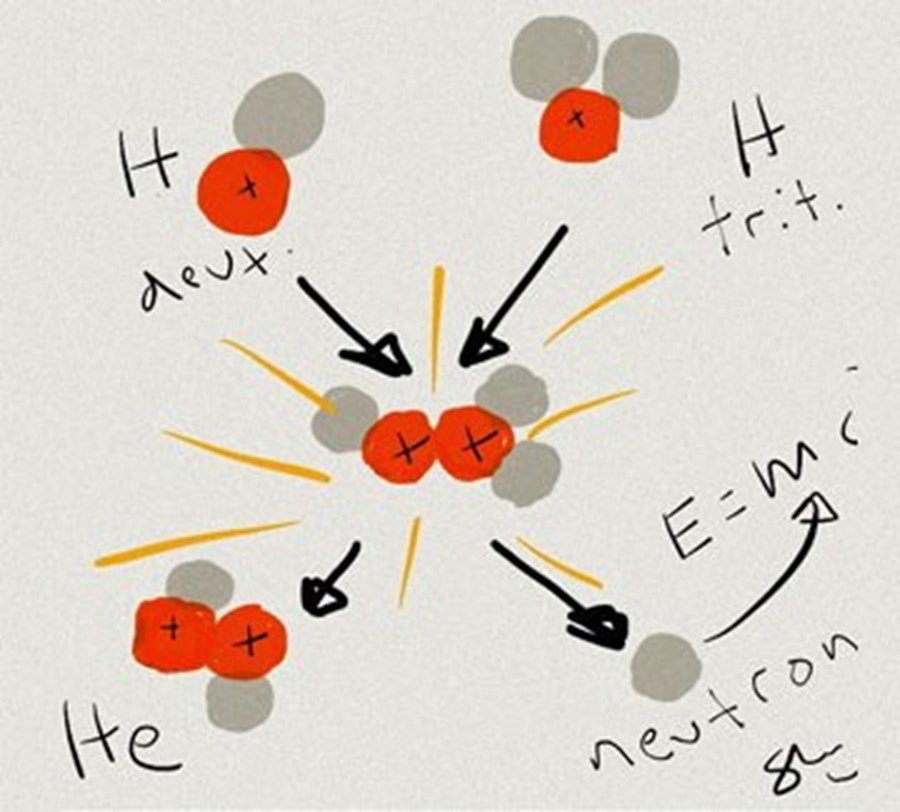Meta & Fysikken: Afsnit 95: Fusionsenergi. Altid 30 år ude i fremtiden!
Idag taler vi om en “hård nød”, som vi mennesker gerne skulle ende med at knække, for rigtigt for alvor at kunne løse energiudfordringerne på lang sigt.
Vi kommer godt rundt, og her er Karina’s noter til dagens afsnit.
What is fusion?
Fusion is the energy source of the Sun and stars. In the tremendous heat and gravity at the core of these stellar bodies, hydrogen nuclei collide, fuse into heavier helium atoms and release tremendous amounts of energy in the process.
Twentieth-century fusion science identified the most efficient fusion reaction in the laboratory setting to be the reaction between two hydrogen isotopes, deuterium (D) and tritium (T), as the DT fusion reaction produces the highest energy gain at the "lowest" temperatures.
Three conditions must be fulfilled to achieve fusion in a laboratory: very high temperature (on the order of 150,000,000 °C); sufficient plasma particle density (to increase the likelihood that collisions do occur); and sufficient confinement time (to hold the plasma, which has a propensity to expand, within a defined volume).
At extreme temperatures, electrons are separated from nuclei and a gas becomes a plasma—often referred to as the fourth state of matter. Fusion plasmas provide the environment in which light elements can fuse and yield energy.
In a tokamak device, powerful magnetic fields are used to confine and control the plasma.
A tokamak is a machine that confines a plasma using magnetic fields in a donut shape that scientists call a torus. (russian acronym of тороидальная камера с магнитными катушками= "toroidal chamber with magnetic coils" )
1:
https://www.sciencealert.com/fusion-is-coming-but-are-we-ready-for-the-problems-it-could-cause
https://www.iaea.org/newscenter/news/what-is-deuterium
Energi forbrug side:
2:
Iter = the way in Latin
ITER will be the world's largest tokamak—twice the size of the largest machine currently in operation, with six times the plasma chamber volume.
What ITER in France goals are:
1) Achieve a deuterium-tritium plasma in which the fusion conditions are sustained mostly by internal fusion heating
Fusion research today is at the threshold of exploring a "burning plasma"—one in which the heat from the fusion reaction is confined within the plasma efficiently enough for the self-heating effect to dominate any other form of heating. Scientists are confident that the plasmas in ITER will not only produce much more fusion energy, but will remain stable for longer periods of time.
2) Generate 500 MW of fusion power in its plasma
The world record for fusion power in a magnetic confinement fusion device is held by the European tokamak JET. In 1997, JET produced 16 MW of fusion power from a total input heating power of 24 MW (Q=0.67). ITER is designed to yield in its plasma a ten-fold return on power (Q=10), or 500 MW of fusion power from 50 MW of input heating power. ITER will not convert the heating power it produces as electricity, but—as the first of all fusion experiments in history to produce net energy gain across the plasma—it will prepare the way for the machines that can.
3) Contribute to the demonstration of the integrated operation of technologies for a fusion power plant
ITER will bridge the gap between today's smaller-scale experimental fusion devices and the demonstration fusion power plants of the future. Scientists will be able to study plasmas under conditions similar to those expected in a future power plant and test technologies such as heating, control, diagnostics, cryogenics and remote maintenance.
4) Test tritium breeding
One of the missions for the later stages of ITER operation is to demonstrate the feasibility of producing tritium within the vacuum vessel. The world supply of tritium (used with deuterium to fuel the fusion reaction) is not sufficient to cover the needs of future power plants. ITER will provide a unique opportunity to test mockup in-vessel tritium breeding blankets in a real fusion environment.
5) Demonstrate the safety characteristics of a fusion device
ITER achieved an important landmark in fusion history when, in 2012, the ITER Organization was licensed as a nuclear operator in France based on the rigorous and impartial examination of its safety files. One of the primary goals of ITER operation is to demonstrate the control of the plasma and the fusion reactions with negligible consequences to the environment.
2005 Decision to site the project in France
2006 Signature of the ITER Agreement
2007 Formal creation of the ITER Organization
2007-2009 Land clearing and levelling
2008 Component fabrication begins
2010-2014 Ground support structure and seismic foundations for the Tokamak Complex
2010-2024 Construction of ITER plant and auxiliary buildings (excepting the Hot Cell Facility)
2012 Nuclear licensing milestone: ITER becomes a Basic Nuclear Installation under French law
2015... Largest components are transported along the ITER Itinerary
2020 Machine assembly begins
2023 Completion of Tokamak Building civil works
2024 Announcement of updated ITER Baseline schedule
3:
https://newatlas.com/energy/iter-private-companies-nuclear-fusion-collaboration/
mindre interessant...
Måske går dette tema meget godt sammen med KLIMA:
4:
Klimaet i 2080:
https://www.sciencealert.com/this-new-map-reveals-the-predicted-future-climate-where-you-live
Her er en webside, hvor man kan se hvad klimaet er om 60 år:
https://fitzlab.shinyapps.io/cityapp/
Man klikker på en by, og så viser den hvilken by lige nu har et klima tilsvarende til hvordan det bliver.
Så hvis du vil vide hvordan klimaet er i Kolding i 2080, så tag på ferie i midten af Frankrig.
I 2080 så er vejret i FFB som i Lombardy ved Gardasøen.
5:
https://videnskab.dk/naturvidenskab/er-klimaet-ved-at-loebe-loebsk-som-i-the-day-after-tomorrow/
Også:
https://www.sciencealert.com/even-climate-scientists-werent-ready-for-2023-and-thats-a-worry
6:

